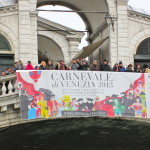
This gallery contains 16 photos.
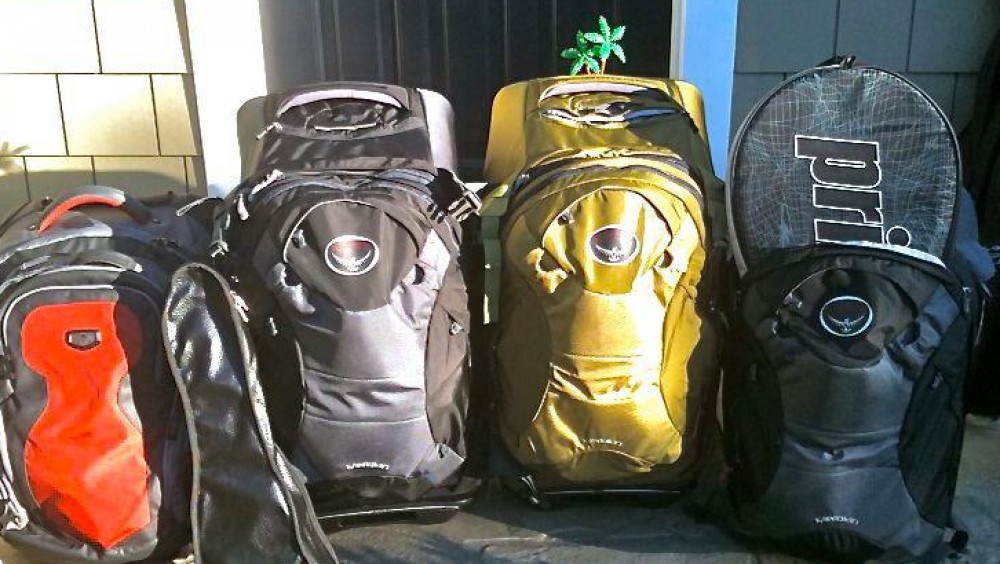

This gallery contains 16 photos.
All molars on the right side. He has two more loose teeth. This is putting economic pressure on the tooth fairy as the euro to dollar exchange rate has been rising and is now 1.37.
This morning, Gigi and I went looking for the weekly market in the town of Massa Lubrense before heading to Positano for a day trip. We knew it was in Piazza Francesca, but did not know exactly where the square was. Turns out it was not in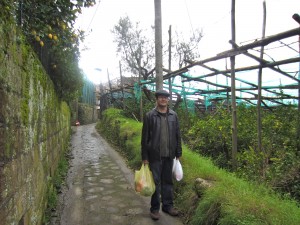 the middle of town, as most weekly markets are. Twice we were given directions, but could not find it after an hour of searching. Our landlady offered to drive us to the market, only 5 minutes away, and then we could walk home. As is turned out, the market was by a church that is up on a hill on a dead end road. Only locals would be able to find this market. We were looking for food, and were surprised to see that 90% of the vendors were selling clothes and household items from vans with amazing canopies that unfolded from the van’s rooftop. It was like a mobile mall of cheap shoes, jeans, winter jackets and such. On the way home we walked down small paths through lemon orchards. The Sorrento area is famous for limoncello, and the local lemons have a protected agricultural designation.
the middle of town, as most weekly markets are. Twice we were given directions, but could not find it after an hour of searching. Our landlady offered to drive us to the market, only 5 minutes away, and then we could walk home. As is turned out, the market was by a church that is up on a hill on a dead end road. Only locals would be able to find this market. We were looking for food, and were surprised to see that 90% of the vendors were selling clothes and household items from vans with amazing canopies that unfolded from the van’s rooftop. It was like a mobile mall of cheap shoes, jeans, winter jackets and such. On the way home we walked down small paths through lemon orchards. The Sorrento area is famous for limoncello, and the local lemons have a protected agricultural designation.
We packed up a picnic lunch and headed for Positano, 45 minutes away on the Amalfi 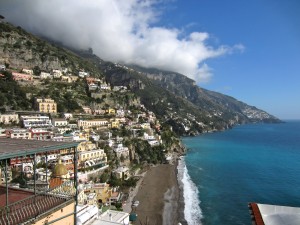 coast. At one point we were on the ridge top of the peninsula and could look to one side and see the Amalfi coast, on the other side was the Bay of Naples. Clouds were brushing the limestone mountaintops above everything. Down the windy road to Positano. Traffic was nil, so the driving was easy, but slow, as this road is famous for being narrow and windy. We parked at the very top of the town and walked down the ‘1,000 steps’ straight to the beach. There were maybe 10 other people on the whole beach. The sun was out, and even though it was only about 13C it felt warm enough for me take my shirt
coast. At one point we were on the ridge top of the peninsula and could look to one side and see the Amalfi coast, on the other side was the Bay of Naples. Clouds were brushing the limestone mountaintops above everything. Down the windy road to Positano. Traffic was nil, so the driving was easy, but slow, as this road is famous for being narrow and windy. We parked at the very top of the town and walked down the ‘1,000 steps’ straight to the beach. There were maybe 10 other people on the whole beach. The sun was out, and even though it was only about 13C it felt warm enough for me take my shirt  off and soak up the low winter sun. The boys stripped down to their underwear and jumped into the Mediterranean. It was cold, but exhilarating, they jumped and shouted and laughed and very soon came out to sun on the pebbly beach. By 3 PM the sun disappeared behind clouds, and without it the beach became suddenly cold. We packed up and walked into the center of town and found it completely shuttered up, so we immediately found the town bus stop and took the bus back to the top of the town and
off and soak up the low winter sun. The boys stripped down to their underwear and jumped into the Mediterranean. It was cold, but exhilarating, they jumped and shouted and laughed and very soon came out to sun on the pebbly beach. By 3 PM the sun disappeared behind clouds, and without it the beach became suddenly cold. We packed up and walked into the center of town and found it completely shuttered up, so we immediately found the town bus stop and took the bus back to the top of the town and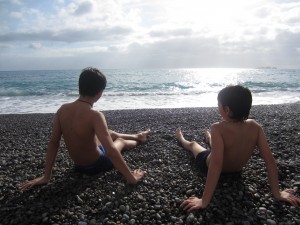 got in our car and headed back to Massa Lubrense.
got in our car and headed back to Massa Lubrense.
Yesterday, we went to Pompeii. For me, this was one of the ‘must see’ destinations on this trip. We found out that we could easily take public transportation from our house to the doorstep of the Pompeii archaeological site, so we decided to give the car a rest this day. 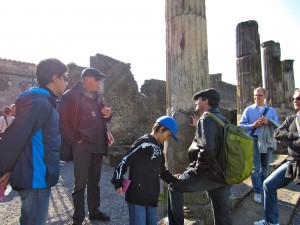 It was a piece of cake, 5-minute walk to bus, bus drops us at Sorrento train station, and train takes us to Pompeii Scavi station 50 meters from the entrance to the ruins. Total travel time with waiting and connections was about 1 ½ hours. I did cost about 35 euros for the family to make the trip.
It was a piece of cake, 5-minute walk to bus, bus drops us at Sorrento train station, and train takes us to Pompeii Scavi station 50 meters from the entrance to the ruins. Total travel time with waiting and connections was about 1 ½ hours. I did cost about 35 euros for the family to make the trip.
We decided to hire a guide at the gate, and were able to split the cost with two Finns so that we paid only 40 euros, which was what the cost would have been to rent audio guide handsets for all four of us. The live guide was definitely the way to go. Rafaele was so informative and interesting. He spent two hours with us. Pompeii was simply amazing. For me, the high point was when we were in the House of the Faun and we saw the mosaic of Alexander 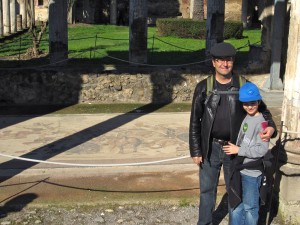
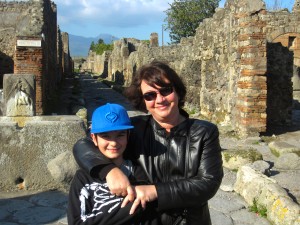 the Great and the wimp Darius of Persia in battle. My heart leapt! This mosaic is pictured in the History textbook that I had taught from for so many years. Upon reflection, I knew this mosaic was in Pompeii, but in the moment it had completely surprised me. Later, I read this is a copy and the original is in a museum in Naples, but that does not matter, the House of the Faun was where it was discovered.
the Great and the wimp Darius of Persia in battle. My heart leapt! This mosaic is pictured in the History textbook that I had taught from for so many years. Upon reflection, I knew this mosaic was in Pompeii, but in the moment it had completely surprised me. Later, I read this is a copy and the original is in a museum in Naples, but that does not matter, the House of the Faun was where it was discovered.
That night we watched a BBC drama on Netflix called ‘Pompeii – The Last Day’ which in dramatic form reinforced the story of what we had all seen and learned about that day. This was a very good way to seal the information about Pompeii for the boys.
Being in Rome, we have been tempted to eat out. Restaurants are ubiquitous, and pizza features prominently in many restaurant windows. Roman style pizza is ultra thin crust and simple in its toppings. The crust simply cannot support the weight of any but the thinnest sliced toppings. The problem with eating out, of course, is two-fold: price and health. Restaurant food is salty and does not offer enough vegetables. Yesterday, we had a constant day of light rain. We did not go out and spent the day as a school day. This also
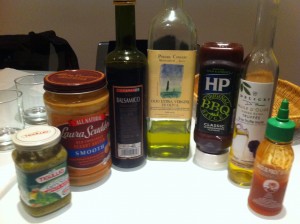
What food staples would you decide are necessary for cooking while traveling? Remember, you have to carry it!
meant that our pantry was low as we did not want to walk to the market, and we had no food for dinner. We wanted to go to a pizza restaurant called Da Remo, considered on several blogs have the best roman-style pizza. However, it was far away, and with the rain we just didn’t want to be outside for long. We ended up at a fish restaurant on the other side of the Piazza Barberini, we walked under the piazza using the metro corridors and stayed out of the rain. Gigi had salmon, and I had a John Dory, split down the middle and grilled. It was delicious and we were happy with the meal. However, it cost 130 euros, which can buy almost 5 days of groceries for us. The price of eating out whammy.
Today, we went to the Campo di Fiori where there is a daily morning outdoor market. The sun was back out and it was a beautiful blue-sky day. Considering that it is the end of  January, we were impressed with the fresh quality and variety of fruits and veggies for sale. We bought 2 purple hued artichokes (they must be in season, restaurants are displaying them) and a chopped vegetable medley ready for minestrone soup. Justin got a large fruit cup, and surprisingly his favorite item was a chunk of fresh coconut. The Campo is lined with restaurants. We patronized Forno Campo de’ Fiori for slices of thin pizza rossa that we ate outside sitting on the fountain. Mine was topped with zucchini flowers and anchovies! This was great, and cheap, street food to snack on to fortify us for our wander through city.
January, we were impressed with the fresh quality and variety of fruits and veggies for sale. We bought 2 purple hued artichokes (they must be in season, restaurants are displaying them) and a chopped vegetable medley ready for minestrone soup. Justin got a large fruit cup, and surprisingly his favorite item was a chunk of fresh coconut. The Campo is lined with restaurants. We patronized Forno Campo de’ Fiori for slices of thin pizza rossa that we ate outside sitting on the fountain. Mine was topped with zucchini flowers and anchovies! This was great, and cheap, street food to snack on to fortify us for our wander through city.
Tonight, we cooked in and had another great meal, healthier and for a fraction of the cost of last night’s meal. And with local ingredients, we felt we were eating Italian. For the antipasti, I used the chopped veggies and made a vegetable soup with chicken bullion 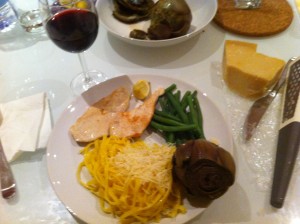 stock and tomato paste. For the primo, we had fresh linguine pasta from the store that we dressed with truffle infused olive oil (Justin’s choice) or pesto (Jordan’s choice). Both the soup and pasta were topped with fresh grated parmesano reggiano. Secondo was scaloppini-style slice chicken breast sautéed in olive oil, garlic, salt and lemon with steamed green beans and the artichokes, steamed with a clove of garlic stuffed in them and drizzled with olive oil. When we can eat in like this using open-air market ingredients, we are totally happy with our meals and feel we really are eating the local food. We are also eating healthier.
stock and tomato paste. For the primo, we had fresh linguine pasta from the store that we dressed with truffle infused olive oil (Justin’s choice) or pesto (Jordan’s choice). Both the soup and pasta were topped with fresh grated parmesano reggiano. Secondo was scaloppini-style slice chicken breast sautéed in olive oil, garlic, salt and lemon with steamed green beans and the artichokes, steamed with a clove of garlic stuffed in them and drizzled with olive oil. When we can eat in like this using open-air market ingredients, we are totally happy with our meals and feel we really are eating the local food. We are also eating healthier.
Buon Appetito!
We woke up Friday morning to blue skies on Friday and decided to go into Siena for the day. We really had not done any research about Siena or the surrounding countryside. I knew that Chianti wine came from somewhere around here, and we saw a Rick Steve’s program featuring San Gimignano. We also knew about the Piazza del Campo and the summer horse races, so that would be our first destination for the day.
Finding parking was our first challenge, as you must park outside of the town center and walk in. We did pretty well, finding parking at the top near the Futbol stadium and thus not having to climb up a hill into the town.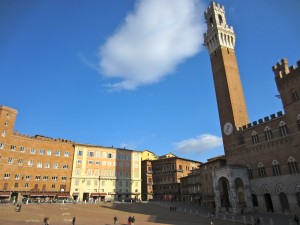
We found the Piazza del Campo easily by just walking down the most crowded streets, as we had left our city map in the car. The Piazza was bathed in the weak winter sunlight, or at least half of it was. Only the cafes, restaurants and gelateria on the northeast side of the square were open. The food establishments on the south and west sides were mostly closed because in that side of the Piazza was in the winter shade and thus cold. We ate lunch outside in our jackets enjoying what solar warmth the low, winter sun had to offer. Justin disappeared regularly into the Piazza to commune with the pigeons. There were a large number of young Americans, most likely university exchange students, wandering the Piazza in groups and calling out to each other. This was the most American English we had heard in the last 6 months. The only dish from lunch worth mentioning was the ribollita soup, a Tuscan vegetable, bean and bread soup that was delicious. I would love the chance to order that one again. As the sun was just about to dip below the buildings and deprive the Piazza of its warmth, we moved on to visit the Duomo. Jordan and Justin both 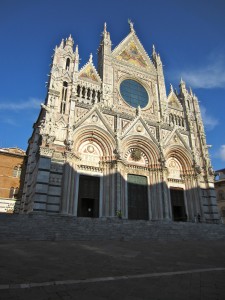 got gelatos in spite of the cold; I guess in Italy gelato stores never close, no matter how cold it gets.
got gelatos in spite of the cold; I guess in Italy gelato stores never close, no matter how cold it gets.
Once out of the sun and walking through the shady wintertime streets, we were all freezing. We found the entrance to the Duomo was free, but all the side rooms charged entry. One room, the Piccolomini Library, had a special exhibit of illuminated songbooks from the 15th century. For some geekish reason I love looking at these medieval handmade books, so we paid for a visit to this room. The Duomo was spectacular. Gigi commented that it might have been the most beautiful church she had ever seen. The 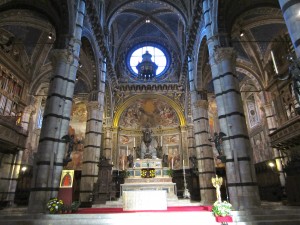
 illuminated manuscripts were also beautiful, and the upper walls and ceiling of the Piccolomini were elaborately painted with medieval and Greek mythological scenes. I love the fact that you can see a picture of a satyr with a long, engorged penis ogling a naked woman under the roof of a Christian cathedral.
illuminated manuscripts were also beautiful, and the upper walls and ceiling of the Piccolomini were elaborately painted with medieval and Greek mythological scenes. I love the fact that you can see a picture of a satyr with a long, engorged penis ogling a naked woman under the roof of a Christian cathedral.
Saturday was a homebound, constant fire in the fireplace day. We woke up to snow again that stuck on the ground for a while, but by the afternoon had turned to rain. No way we were going out. It was cold! We did a lot of schooling with the boys and watched movies in the evening. We have discovered that with a VPN account, we could sign up for Netflix and get all the streaming movies and TV shows we want, no matter what country we are in. This is a new twist for us on this trip. In Grimaud, we had Sky TV with all its English language programming. We have also been using iTunes for movies, Once Upon a Time, Vampire Diaries, and the Daily Show. Netflix is much cheaper than using iTunes.
Checking the weather online that day, it looked as if our entire stay in Tuscany was going to be overcast with daily rain. This was a turn for the worse as just a few days earlier the forecasts had shown at least a few dry days.
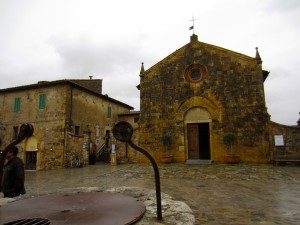 On Sunday we took a day trip to Monteriggioni and San Gimignano. The skies were overcast and we had sporadic rain all day, but in spite of this we were pretty much dry for all our sightseeing. We had seen the turreted walls of Monteriggioni from the SR2 road when we first came into Siena. This medieval walled hamlet (pop. 42, I read), 20 minutes from our house, has only two entrance gates wide enough for one car lane and a large central square. You are supposed to be able to walk the battlement of the walls, but unfortunately this tourist option was closed from January 14th until February 14th. Justin
On Sunday we took a day trip to Monteriggioni and San Gimignano. The skies were overcast and we had sporadic rain all day, but in spite of this we were pretty much dry for all our sightseeing. We had seen the turreted walls of Monteriggioni from the SR2 road when we first came into Siena. This medieval walled hamlet (pop. 42, I read), 20 minutes from our house, has only two entrance gates wide enough for one car lane and a large central square. You are supposed to be able to walk the battlement of the walls, but unfortunately this tourist option was closed from January 14th until February 14th. Justin 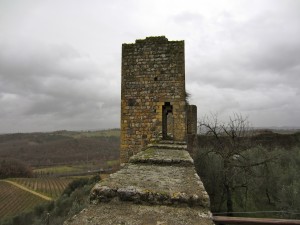 and Jordan hopped the locked gate to get up there for a quick look around. The place was pretty dead and no one noticed. There were only a handful of tourists walking around. Monteriggioni was very quaint and old, only one restaurant was lively with lunchtime patrons, and after maybe 30 minutes we were done with this place.
and Jordan hopped the locked gate to get up there for a quick look around. The place was pretty dead and no one noticed. There were only a handful of tourists walking around. Monteriggioni was very quaint and old, only one restaurant was lively with lunchtime patrons, and after maybe 30 minutes we were done with this place.
San Gimignano was about a 30-minute drive from Monteriggioni, and once we got into view of the town, the countryside changed. I would say the area we are staying in to the west of Siena looks a bit scruffy and wild with weedy fields that haven’t been tilled yet for the summer crop planting. Around San Gimignano, on the other hand, the olive orchards, vineyards and farmhouses are orderly and really look like money has being poured into them. Tidy and clean. San Gimignano was a beautifully preserved medieval town.
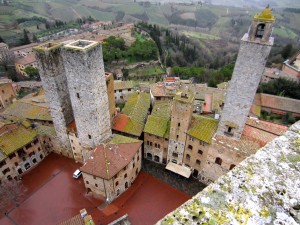 It is set up as a major tourist town with large parking lots outside of the city walls. Again, with this being the lowest possible tourist time, we parked in the closest lot to one of the gates with no problem. The boys and I climbed the stairs of the Torre Grossa for a panoramic view of the town and countryside. We also popped into the Civic museum to look at the religious artwork from the 14th and 15th centuries. Justin commented that one of the Jesus crucifixion pictures was ‘creepy’, and indeed it was as Jesus had unnaturally long, skinny arms and legs with extra bloody nails. It did provide a good art lesson, as the paintings spanned the time from medieval to renaissance art. It was easy for the boys to see the difference in the ways the painters from these eras were able to represent human forms and move from flat representations to depth of a scene. We spent time in a café drinking hot drinks and playing Uno and Bananas. On the way out, I bought bottles of local red Chianti wine and white Vernaccia wine. Chianti is well known, but I had never heard of Vernaccia and read it is special to this area and was mentioned in Dante’s Inferno, which gives it some fame.
It is set up as a major tourist town with large parking lots outside of the city walls. Again, with this being the lowest possible tourist time, we parked in the closest lot to one of the gates with no problem. The boys and I climbed the stairs of the Torre Grossa for a panoramic view of the town and countryside. We also popped into the Civic museum to look at the religious artwork from the 14th and 15th centuries. Justin commented that one of the Jesus crucifixion pictures was ‘creepy’, and indeed it was as Jesus had unnaturally long, skinny arms and legs with extra bloody nails. It did provide a good art lesson, as the paintings spanned the time from medieval to renaissance art. It was easy for the boys to see the difference in the ways the painters from these eras were able to represent human forms and move from flat representations to depth of a scene. We spent time in a café drinking hot drinks and playing Uno and Bananas. On the way out, I bought bottles of local red Chianti wine and white Vernaccia wine. Chianti is well known, but I had never heard of Vernaccia and read it is special to this area and was mentioned in Dante’s Inferno, which gives it some fame.
 Monday was another hill town outing, this time south to Montepulciano and Pienza, with a stop on the return to the monastery of Monte Olivieto Maggiore. We were very lucky with the weather these past two days of exploration. Both nights it poured rain, but during our times outside we stayed dry. We even got some nice sunshine on Sunday, but it was quite chilly. These two towns did not impress us as much as yesterdays’.
Monday was another hill town outing, this time south to Montepulciano and Pienza, with a stop on the return to the monastery of Monte Olivieto Maggiore. We were very lucky with the weather these past two days of exploration. Both nights it poured rain, but during our times outside we stayed dry. We even got some nice sunshine on Sunday, but it was quite chilly. These two towns did not impress us as much as yesterdays’. In Montepulciano, ALL the stores were closed, the town was fairly deserted, and it was cold. Our main goal was to eat lunch in this town, and as we walked the town looking for a restaurant, with running comments from the boys of, “I’m hungry, this one looks fine, the last one looked fine, where are we going,” we ended up at the very first restaurant we saw just inside the town gate. We had a good lunch; the boys ordered pici pasta,
In Montepulciano, ALL the stores were closed, the town was fairly deserted, and it was cold. Our main goal was to eat lunch in this town, and as we walked the town looking for a restaurant, with running comments from the boys of, “I’m hungry, this one looks fine, the last one looked fine, where are we going,” we ended up at the very first restaurant we saw just inside the town gate. We had a good lunch; the boys ordered pici pasta, 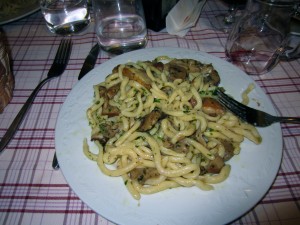 the special Tuscan style of pasta. I got another chance to have a bowl of ribollita soup. This meal was so filling that Gigi and I skipped dinner that night. I have no idea how Italians order an antipasti, primero, secondi, dolce, and then actually eat it all.
the special Tuscan style of pasta. I got another chance to have a bowl of ribollita soup. This meal was so filling that Gigi and I skipped dinner that night. I have no idea how Italians order an antipasti, primero, secondi, dolce, and then actually eat it all.
After lunch, I popped into an enoteca to try the local wine called Vino Nobile di Montepulciano. The bottles of wine sold for the princely sum of 15 euros.I was told they are aged in oak barrels for 3 years. Good stuff, but when I can get great Chianti Classico for 7 euros, I skipped buying any bottles.
Our visit to Pienza was very short, maybe and hour. We arrived fairly late in the afternoon and still wanted to visit the monastery. The town was tiny, but very picturesque. Also again empty and cold. A pope came from Pienza, and he commissioned some palaces around the tiny town square that are famed to be classic examples of Renaissance architecture. 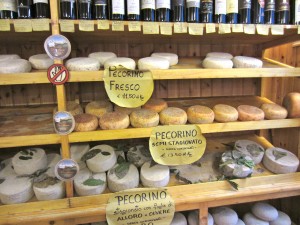 Pienza is also famous for producing the best pecorino cheese, and we found a cheese store open. It had like 15 types of pecorino in various stages of ageing and flavoring. We only know the dry, aged pecorino in the US. We bought a chunk each of ‘fresca’ and the aged type that is familiar in the US. The guy behind the counter was the worst salesman; he kept his nose in his paper and gave us cheese to taste with minimal exertion and no explanations. Out of Pienza, Gigi had me stopping every 3 minutes to take a landscape photo.
Pienza is also famous for producing the best pecorino cheese, and we found a cheese store open. It had like 15 types of pecorino in various stages of ageing and flavoring. We only know the dry, aged pecorino in the US. We bought a chunk each of ‘fresca’ and the aged type that is familiar in the US. The guy behind the counter was the worst salesman; he kept his nose in his paper and gave us cheese to taste with minimal exertion and no explanations. Out of Pienza, Gigi had me stopping every 3 minutes to take a landscape photo.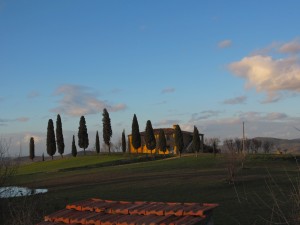
We wanted to visit the Monastery of Monte Olivetto Maggiori because they do mass and vespers in Gregorian chant. They also have a monastic library that can be visited. This place made me think of the novel The Name of the Rose, because they have a Latin translation copy of The Divine Comedy. Unfortunately, this visit was 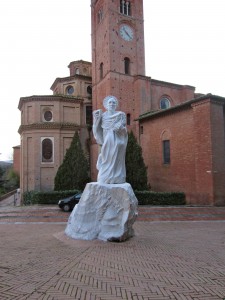 a bust.
a bust.
We arrived after closing, in winter the monastery closes one hour earlier than in summer. The place was completely locked up with no one in sight to ask about the vespers service, and although we waited outside the church, when the time for vespers came, we could hear no sound, no music.
Tuesday was a school day out on the farm, and a run into Siena to the only self-service Laundromat in the city. We had to walk our bags of dirty clothes into the old town near the Campo, again passing twenty-something American girls in the streets. There were 3 of them in the Laundromat. Is it every American college girl’s dream to study a semester abroad in Italy? Gigi and I struck up a conversation with an American couple that was at the end of a 5-week stay in Tuscany. Like us, they had loved Lucca.
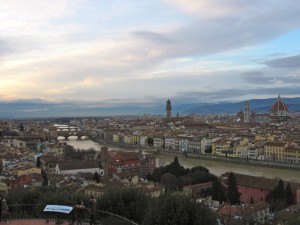
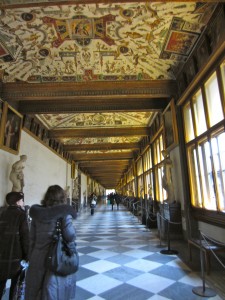

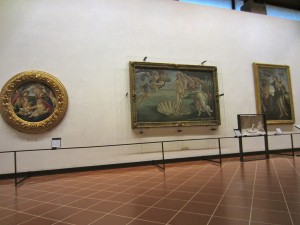 Wednesday was our final day in Tuscany. We took the hour drive back up to Florence with one goal: visit the Uffizi gallery. We parked at the Piazzale Michelangelo, which has free parking and the best view across the Arno River and over the city. We had our picnic lunch up there. A 20-minute walk brought us to the Uffizi Museum.
Wednesday was our final day in Tuscany. We took the hour drive back up to Florence with one goal: visit the Uffizi gallery. We parked at the Piazzale Michelangelo, which has free parking and the best view across the Arno River and over the city. We had our picnic lunch up there. A 20-minute walk brought us to the Uffizi Museum.
We walked right in, no lines, and no advanced ticket sale. The boys, for the most part, did an excellent job staying engaged and interested. I had prepped them with the Uffizi’s website’s short list of ‘must see’ paintings, which became our treasure hunt. We rented audioguides. The boys brought their iPads to do sketches using the app Paper. For Justin, this ended up being mostly using the color pad to try to match the colors he was seeing in the painting. When we were done with the Uffizi, we headed back over the Arno on the Ponte Vecchio, grabbed a gelato, and headed back to Siena. Tomorrow we were heading to Rome.
We had a long drive this day. A cold storm started yesterday and was continuing today. 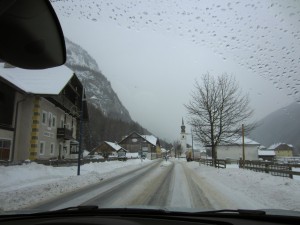 For this reason, we decided to head south a far as possible to get away from the snow and colder weather. We originally thought of visiting over the next three days Salzburg, only an hour from Obertauern, Verona, and the Ferrari museum/factory outside of Modena before heading to Siena. These places would have to wait for our return trip north to Germany. We did not need chains for our drive out, but for the first 20 km or so I pretty much stayed in second gear. It was normal driving once we made it to the autobahn. We drove out the same way we had come into Austria. A week earlier we were won
For this reason, we decided to head south a far as possible to get away from the snow and colder weather. We originally thought of visiting over the next three days Salzburg, only an hour from Obertauern, Verona, and the Ferrari museum/factory outside of Modena before heading to Siena. These places would have to wait for our return trip north to Germany. We did not need chains for our drive out, but for the first 20 km or so I pretty much stayed in second gear. It was normal driving once we made it to the autobahn. We drove out the same way we had come into Austria. A week earlier we were won
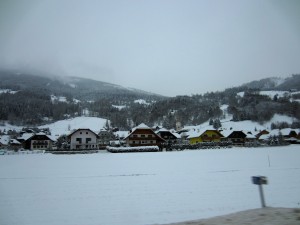
dering when we would get into the snow. Now, we were wondering where the snow would stop. The mountains were covered all the way into Italy, and out on the plains to the south we even saw a sprinkling of snow in the fields. To the north we could see the Alps for several hours. On the way to Austria we had not seen the Alps because of fog and darkness. In the afternoon around Bologna we even got snow again – thick, fat, wet flakes. There was snow crossing the Appenines. Only when we got down by Florence did it seem we were done with snow
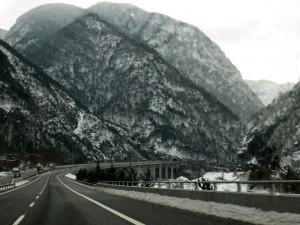
We ate dinner at a McDonalds in Siena (only our second time this trip), and when we came out…snow. It was not sticking, but it was snowing in Siena. We woke the next morning to bright blue skies, cold but not freezing. We were in Tuscany for our second visit.
Today we said ‘au revoir’ to the farmhouse in Grimaud. We had spent 3 months there, and it was time to move on. As always, all our stuff fit into the car, but it was much tighter. We have accumulated ‘stuff’ – more clothes for cold weather, art supplies, books and notebooks, food staples for cooking, and we also have our winter gear for skiing in Austria. In December, Gigi travelled home with a suitcase full of Christmas gifts and returned to France with a full suitcase of our ski clothes. We also bought snow boots here for everyone. We were set to spend a week in the Alps.
Justin had his last group tennis lesson in the morning, and we picked him up and left straight from the courts. We had one other quick stop to say goodbye to the only friends we made in Grimaud, Anita and her two kids, and we were off.
The A8 eastbound has become very familiar to us and in a few hours we were in Italy on the Autostrada Fiori towards Genoa. This was the way we had taken to Lucca in October for our first trip to Italy. At Genoa, we turned east towards Venice. After less than an hour we were across the mountains and into the Po river valley. After driving through the Cote d’Azur and Liguria, the absolute flatness of the river plain was quite astonishing. The freeway also straightened out and became mostly 3 lanes with a constant 130 km/hr, which made driving much easier. When we crossed the Po River, we were all surprised that such a small river had created this expansive floodplain/valley. I wonder how big the Po was in times past, before the demands of agriculture and cities pumped away its water. When we passed through Verona, Jordan made the comment that ‘it looked like California.’ He was commenting on the 6-lane freeway, the concrete overpasses and modern office buildings flanking us. Funny, we are going to visit Verona later because it is a well-preserved historical city, but here we were seeing the modern Italy.
We ended the day’s journey in the city of Udine, which placed us about a 3-hour drive from Obertauern the next day. We stayed in a Best Western hotel outside the town center for easy freeway access and gated parking since our car was packed with all our stuff. For dinner the clerk recommended a pizza restaurant 2 blocks away next to a VW dealership. The neighborhood was definitely drab, and we doubted the restaurant would be any good. How wrong we were. The place had a modern interior and was packed on a Wednesday night, of course only with locals. It was called ‘Anconadue.’ We had the best wood fired pizza! Justin still claimed that Speederia pizza was better. He always does. Apparently, to him the fresh Italian ricotta cheese on this pizza did not match the flavor of the ricotta on Spederia’s Whitestone pizza. Jordan and I disagreed, this pizza was exceptional.
The next morning we headed north through a fog. It felt like driving on HWY 80 in the winter with the Tule fog. The land was still completely flat. Justin kept asking where the Alps were. Maybe 20 minutes out of Udine, with the land still flat, we could discern mountains through the fog. The southern front guard of the Alps jutted like teeth from the gums of the plain. They were steely grey, as the mountainsides were steep to the point of being cliff-like, and there was very little soil on them for trees to grow. We entered a river valley with a wide, gravelly floodplain. The river water was a milky aquamarine. This alpine landscape was all so sudden; there was absolutely no prelude of rolling hills, and with the fog we were in there was no chance to see it from a distance. The freeway was beautiful and looked almost new. We travelled through several tunnels, and until we reached Villach, we had the northbound lanes all to ourselves. At Spittle an der Drau, there was still no snow on the ground, and we were only 40 minutes away from Obertauern. We could see snow on the mountain peaks, but at the moment I was wondering what kind of snow conditions we would find in Obertauern. What a difference we found in a short time. We climbed 1000 meters (3200 feet) from Spittal to Obertauern and found ourselves in a winter wonderland. We checked in at the Aparthotel Steinadler before dark and got our ski rentals squared away for the next day. Two gondola lifts are 150 meters from our apartment. We were going to ski – and snowboard (Justin) – in the Austrian Alps tomorrow.
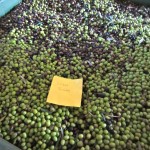
This gallery contains 6 photos.
Last week, my family and I took a mini vacation. We went to Italy and stayed in a beautiful area near the town of Lucca, Italy. The house had a huge property with grape vines and olive trees everywhere. They had … Continue reading
This is a road for Ferraris. Just get rid of the other cars and the speed limits.
We drove from Grimaud to Lucca, which takes 5 ½ hours in the car. Two hours of this drive are on the Autostradas dei Fiori and Azzura, which run from the Italy/France border to about La Spezia, on the border of Liguria and Tuscany. When we were in Norway, the number of roadway tunnels south of Trondheim amazed us. I think the highway in Liguria surpassed the number of tunnels we travelled through in Norway. And when we were not in a tunnel, we were often driving on a viaduct bridge that crossed over an often ravine-like valley. Towns crowded the mouths of these valleys at the Mediterranean’s edge. Sightseeing if you are the driver is not advised. The road was rarely straight and you had to be constantly alert. The highway is a divided road with two lanes in each direction. That was the good part. There are no shoulders, only SOS pullout spots. The on and off ramps have very short merge/exit lanes with 90 degree turns, which means you have to be alert to slow cars if you are in the right lane when going through these zones. There was almost constant roadwork, so there was extra signage with different speed limits. The speed limits would shift from 60 to 80 to 90 to 110 to 130 in very short time intervals. I kind of gave up on worrying about the limit and drove an even 90 – 110 like most other people. Traffic itself was a challenge. There were the multitude of truckers who have a speed limit of 90 Kmh and the Mercedes owners who are flashing their lights behind you in the fast lane wanting to pass even if you are going 130 Kmh. Weaving between the slow trucks in the right and getting out of the way of the speeders in the left lane meant lots of lane changing. It felt to me like driving on the Bay Bridge in San Francisco for two hours, with lots of curves thrown in. My hands were tired from gripping the wheel after this drive.
Oh, and as we found in France, the Autostradas in Italy are toll roads. The cost from the border to near Lucca was 32.50 Euro.





